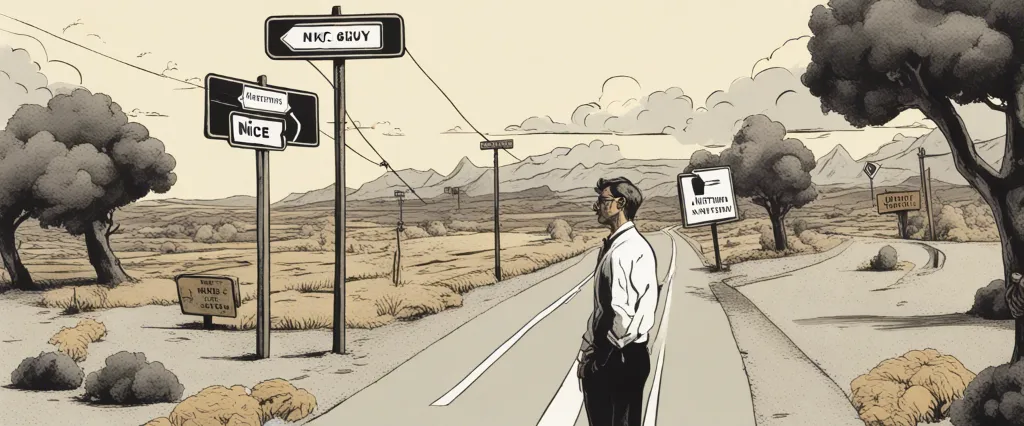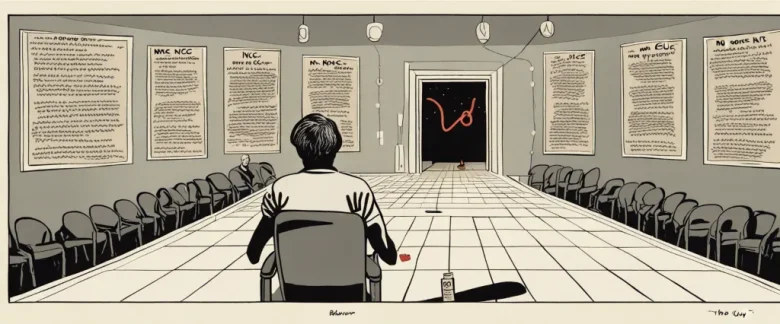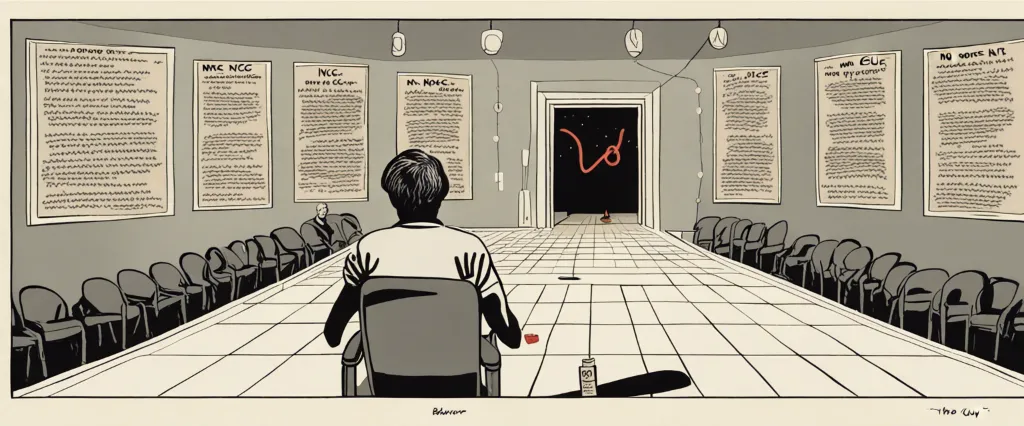In “No More Mr. Nice Guy,” Robert A. Glover delves into the realms of personal growth and self-help to challenge the long-held beliefs and behaviors of so-called “nice guys.” Through his extensive experience as a therapist and his own personal journey, Glover unveils the hidden patterns and insecurities that plague many men, preventing them from achieving genuine fulfillment in their relationships and lives. In this transformative guide, he offers practical strategies, exercises, and insights to help men unravel the limiting beliefs and behaviors that hinder their emotional well-being and hinder the development of their true selves. Robert A. Glover is an internationally recognized therapist, workshop leader, and author specialized in men’s issues. With over 30 years of experience, he has helped countless men reclaim their personal power, deepen their connections, and live a more authentic and satisfying life.
Chapter 1: The Nice Guy Syndrome
Chapter 1 of “No More Mr. Nice Guy” by Robert A. Glover sets the foundation for understanding the concept of the “Nice Guy Syndrome” and its effects on men’s lives. The chapter begins by introducing the author’s personal experience and research, showcasing how many men struggle with being “nice guys” and facing the challenges it brings.
Glover highlights that Nice Guys often go through life seeking approval and validation from others, particularly women, in exchange for avoiding conflict and maintaining a harmonious atmosphere. They believe that by being nice, understanding, and generous, they can win love, acceptance, and fulfillment. However, these men often find themselves frustrated as their efforts go unnoticed or unappreciated.
The chapter further explains the Nice Guy Syndrome by exploring the origins of this behavior. Glover suggests that it usually stems from childhood experiences such as strict upbringing, parental expectations, or traumatic events that shaped the Nice Guy’s belief system. As a result, Nice Guys learn to put others’ needs before their own, avoid confrontation, and suppress their desires and emotions.
The author emphasizes that the Nice Guy Syndrome ultimately leads to dissatisfaction, as men’s repressed needs and desires surface in unhealthy ways. They often have difficulty setting boundaries, struggle with genuine intimacy, and become passive-aggressive or manipulative in their relationships.
Chapter 1 concludes by emphasizing the importance of acknowledging and understanding the Nice Guy Syndrome as the first step towards personal growth and well-being. The author encourages men to embrace their desires, practice self-assertion, and work on developing genuine connections with others.
In summary, Chapter 1 of “No More Mr. Nice Guy” introduces the concept of the Nice Guy Syndrome, explores its origins in childhood experiences, and highlights the negative impact it has on men’s lives. Glover emphasizes the need for self-awareness and personal growth to break free from the limitations of the Nice Guy persona.
Chapter 2: The Origins of Nice Guy Syndrome
Chapter 2 of “No More Mr. Nice Guy” by Robert A. Glover explores the origins of “Nice Guy Syndrome” and provides insights into why some individuals develop this pattern of behavior. The chapter delves into childhood experiences and upbringing as key factors that contribute to the development of Nice Guy Syndrome.
Glover explains that many Nice Guys have experienced some form of emotional, physical, or sexual trauma during their childhood. These traumas can create a deep-seated fear of rejection and a belief that their needs and desires are not worthy of acknowledgement. Consequently, to avoid being rejected or abandoned, Nice Guys develop behaviors aimed at pleasing others, often sacrificing their own needs and desires in the process.
The author suggests that Nice Guys often grow up in problematic family dynamics. They may have experienced a lack of emotional support from their parents, witnessed volatile relationships, or experienced shaming and criticism. These childhood experiences lead them to believe that their natural desires and emotions are not valid, and they must keep them hidden to avoid conflict or disappointment.
Nice Guys often become overachievers, seeking external validation through accomplishments and striving to be perfect in order to gain love and acceptance. They also tend to become passive-aggressive, avoiding direct confrontation and suppressing their true feelings for fear of rejection or conflict.
The chapter concludes by highlighting the role of shame in the development of Nice Guy Syndrome. The experiences of rejection, emotional neglect, or criticism during childhood lead Nice Guys to believe that they are fundamentally flawed and unworthy of love. This sense of shame drives their people-pleasing behaviors and deepens their fear of rejection.
By understanding the origins of Nice Guy Syndrome, individuals can begin unraveling the patterns and beliefs that have shaped their behavior. Recognizing the impact of childhood experiences and addressing the underlying shame can be the first steps toward breaking free from the cycle of people-pleasing and reclaiming their authentic selves.
Chapter 3: The Covert Contracts of Nice Guys
Chapter 3 of “No More Mr. Nice Guy” by Robert A. Glover explores the concept of covert contracts in the lives of Nice Guys. Glover defines covert contracts as the unspoken agreements or expectations that Nice Guys hold within themselves and project onto others, usually resulting in disappointment, frustration, and resentment.
These covert contracts typically follow a similar pattern. Nice Guys believe that by being nice, pleasing, and making others happy, they will eventually be rewarded with love, attention, sex, or their needs being met. However, as these contracts are never clearly communicated or agreed upon, they lead to internal frustration when the expected rewards do not materialize.
Nice Guys often struggle with expressing their needs and desires openly and directly, believing that others should automatically know and fulfill them without explicit communication. They engage in people-pleasing behaviors, attempting to be indispensable by putting others’ needs above their own, while harboring expectations that others will reciprocate without being asked.
Glover identifies three main types of covert contracts: tit-for-tat contracts, peacekeeper contracts, and yes-dear contracts. Tit-for-tat contracts involve Nice Guys expecting something in return for their good deeds, often keeping a mental tally of how many favors they have done and feeling grievance when their efforts go unrecognized. Peacekeeper contracts involve avoiding conflict and keeping the peace at all costs, hoping that by preventing any disruption, others will naturally meet their needs. Finally, yes-dear contracts occur when Nice Guys comply with their partner’s desires without expressing their own needs, hoping to maintain harmony and avoid rejection.
Ultimately, Glover highlights that covert contracts perpetuate the Nice Guy’s lack of fulfillment and reinforce their belief that they are not truly deserving of love and acceptance. He suggests that breaking these contracts is crucial for Nice Guys to embrace their authenticity, communicate their needs openly, and develop healthy relationships based on genuine connection rather than hidden expectations.
Chapter 4: Nice Guys and Sexuality

In Chapter 4 of “No More Mr. Nice Guy” by Robert A. Glover, titled “Nice Guys and Sexuality,” the author focuses on the connection between the “nice guy” syndrome and difficulties with sexuality. Glover emphasizes that many self-identified nice guys struggle with their sexual relationships and have unhealthy patterns in their approach to sex.
The chapter begins by stating that nice guys often have a distorted understanding of sex and its role in relationships. They tend to have internalized beliefs that their sexual desires are wrong, shameful, or even perverted. This can lead to various issues like sexual anxiety, performance anxiety, and dishonesty with their partners.
Glover proposes that the nice guy’s desire to be liked by everyone affects their sexuality. They believe that expressing their desires or boundaries will make them less likeable, so they suppress their own sexual needs and become overly focused on pleasing their partner. This leads to a lack of assertiveness and an inability to ask for what they want in the bedroom, resulting in dissatisfaction and unfulfilled desires.
Furthermore, the author highlights that nice guys often use indirect methods to try to access sex, such as earning it through acts of kindness or seeking validation. They tend to place their own needs below those of their partner, hoping that being constantly nice will eventually lead to sex. However, this approach can foster resentment and frustration within themselves.
To overcome these challenges, Glover advises nice guys to develop healthy sexual attitudes and behaviors. This involves identifying their desires, embracing their sexuality, and being authentic in their relationships. He stresses that nice guys need to learn to communicate their needs openly and honestly, and to prioritize their own pleasure and desires without guilt or shame.
In summary, Chapter 4 explores the connection between the nice guy syndrome and sexuality. It emphasizes that nice guys often struggle with sexual fulfillment due to their fear of rejection, people-pleasing tendencies, and distorted views on sex. The author encourages nice guys to establish healthy sexual attitudes by asserting their needs, embracing their desires, and developing open communication with their partners.
Chapter 5: Nice Guys and Relationships
Chapter 5 of “No More Mr. Nice Guy” by Robert A. Glover explores the connection between nice guys and their relationships. The chapter delves into how nice guys often struggle with intimacy and maintaining healthy romantic partnerships.
Glover explains that nice guys tend to struggle with intimacy because they fear rejection and have a deep-seated belief that their needs and desires are not important. They mistakenly believe that being agreeable and always putting others’ needs before their own will earn them love and acceptance. However, this approach creates a dynamic where their own needs remain unmet, leading to frustration and resentment.
The author emphasizes that nice guys often seek validation externally and are concerned with pleasing their partners at all costs. In relationships, they may suppress their true feelings and desires, avoid conflict, and become overly accommodating. These behaviors prevent authentic connection and hinder the growth of healthy partnerships.
To overcome these challenges, Glover suggests that nice guys should start by focusing on self-awareness and self-validation. They need to recognize their own needs and desires, develop clear boundaries, and express themselves honestly. This self-empowerment allows nice guys to cultivate genuine intimacy and foster relationships based on mutual respect.
Furthermore, Glover encourages nice guys to enter relationships as whole individuals rather than seeking validation solely from their partners. Building a strong sense of self and pursuing independent interests ultimately makes them more attractive and capable partners.
In summary, Chapter 5 highlights the difficulties nice guys face when it comes to intimacy and relationships. It emphasizes the importance of self-validation, setting boundaries, and fostering authenticity as essential steps towards developing healthy and fulfilling romantic connections.
Chapter 6: Nice Guys and Career
Chapter 6 of “No More Mr. Nice Guy” by Robert A. Glover focuses on the concept of “Nice Guys” in the context of their careers and professional lives. The author analyzes the behaviors, beliefs, and patterns that limit their success and suggests ways to break free from these self-imposed limitations.
Glover explains that Nice Guys typically adopt a passive approach to their careers, avoiding conflict and confrontation at all costs. They often prioritize the needs and desires of others over their own, believing that being kind, agreeable, and accommodating will lead to success. However, this approach often leads to unfulfilling careers, resentment, and a lack of personal achievements.
The chapter emphasizes how Nice Guys may struggle to ask for what they want or confront their superiors when they feel mistreated or undervalued. Their fear of rejection and desire for approval hinder their ability to negotiate for better positions, promotions, or salaries. Glover explains that Nice Guys may also avoid taking risks or seeking challenging opportunities out of fear of failure or disapproval from others.
To overcome these limitations, the author encourages Nice Guys to develop a more assertive and authentic approach. This involves identifying their own desires, setting boundaries, and speaking up for themselves. Glover advises readers to start by expressing their needs and wants, taking appropriate risks, and seeking support from mentors or career coaches.
In summary, Chapter 6 addresses the tendency of Nice Guys to limit their professional success by subduing their own desires, avoiding conflict, and seeking approval. By adopting a more assertive and authentic mindset, Nice Guys can break free from these patterns and pursue fulfilling and prosperous careers.
Chapter 7: Nice Guys and Their Families
Chapter 7 of No More Mr. Nice Guy by Robert A. Glover focuses on the relationship between Nice Guys and their families. In this chapter, Glover examines how growing up in dysfunctional families can contribute to the development of the Nice Guy syndrome.
The chapter begins by highlighting how Nice Guys often come from families where there is a lack of emotional connection, compassion, and healthy communication. These families may have been characterized by neglect, abuse, or excessive control, leading Nice Guys to develop various coping mechanisms to survive and gain validation.
Glover explains that Nice Guys typically learn to hide their needs and feelings in order to avoid potential conflict or rejection from their families. They become people-pleasers and learn to adapt to the needs of others, often sacrificing their own happiness and desires.
Additionally, the author discusses the impact of the “rule of silence” in dysfunctional families, where issues are avoided or denied, and open expression of emotions is suppressed. This lack of emotional expression can lead Nice Guys to become emotionally unavailable or unable to identify and express their own needs and desires.
Glover emphasizes that in order to overcome the Nice Guy syndrome, individuals must examine and heal their relationship with their families. This involves recognizing the dysfunction and its impact on their behavior, letting go of blame, and developing healthy boundaries with family members.
Overall, Chapter 7 explores the pivotal role of family dynamics in shaping the Nice Guy syndrome. Understanding these dynamics helps individuals take ownership of their patterns of behavior and empowers them to break free from the cycle of seeking validation and sacrificing their own needs.

Chapter 8: Breaking Free from the Nice Guy Syndrome
Chapter 8: Breaking Free from the Nice Guy Syndrome of the book No More Mr. Nice Guy by Robert A. Glover focuses on how to overcome the traits and behaviors associated with the Nice Guy Syndrome.
Glover begins by reiterating that Nice Guys often have a deep-rooted fear of rejection and abandonment, which leads to them seeking approval from others in order to feel safe and secure. However, this constant need for validation results in them neglecting their own needs and desires.
To break free from this pattern, Glover suggests that Nice Guys must first confront their fear of rejection and learn to embrace discomfort. This involves stepping out of their comfort zones and taking risks, even if it means facing potential criticism or disapproval from others. By doing so, they can begin to build authentic connections with people and create a more fulfilling life.
Furthermore, Glover emphasizes the importance of setting boundaries and saying no. Nice Guys often struggle with setting limits and asserting themselves, as they fear conflict and causing disappointment. However, Glover asserts that establishing boundaries is crucial for healthy relationships and self-respect. By learning to prioritize their own needs and desires, Nice Guys can overcome their people-pleasing tendencies.
In addition, Glover emphasizes self-care as a crucial aspect of breaking free from the Nice Guy Syndrome. He advises Nice Guys to focus on their own well-being, engage in activities that bring them joy, and take responsibility for their own happiness. This involves developing hobbies, pursuing personal goals, and taking care of their physical and mental health.
Overall, Chapter 8 provides practical strategies for Nice Guys to break free from their self-sabotaging patterns and start living more authentic, fulfilling lives. It emphasizes the importance of embracing discomfort, setting boundaries, and prioritizing self-care in order to overcome the Nice Guy Syndrome.
After Reading
In conclusion, “No More Mr. Nice Guy” by Robert A. Glover offers a profound understanding of the challenges faced by men who struggle with being too “nice” and seeking external validation. The book provides practical insights and techniques for breaking free from these limiting patterns and cultivating a healthy, authentic sense of self. From examining the origins of the “nice guy syndrome” to exploring the negative consequences it can have on relationships, Dr. Glover offers a comprehensive roadmap for personal growth and transformation. By working through exercises, setting boundaries, and embracing one’s masculine power, men can enhance their confidence, improve their relationships, and live a more fulfilling life. With its straightforward advice and relatable anecdotes, this book serves as a valuable resource for any man ready to shed the label of being a “nice guy” and embrace true authenticity.
1. Models: Attract Women Through Honesty” by Mark Manson: This book explores the concept of self-improvement and personal growth to attract romantic relationships by focusing on authenticity and being true to oneself.
2. “The Art of Non-Conformity: Set Your Own Rules, Live the Life You Want, and Change the World” by Chris Guillebeau: This book encourages readers to break free from societal norms and expectations, encouraging personal happiness and fulfillment through unconventional methods.
3. “Boundaries: When to Say Yes, How to Say No to Take Control of Your Life” by Dr. Henry Cloud and Dr. John Townsend: Similar to “No More Mr. Nice Guy,” this book emphasizes the importance of setting boundaries, learning to say no, and taking control of one’s own life to achieve personal growth and happiness.
4. The Subtle Art of Not Giving a F*ck: A Counterintuitive Approach to Living a Good Life” by Mark Manson: Mark Manson challenges conventional wisdom, encouraging readers to focus on what truly matters in life and let go of unnecessary worries and concerns, ultimately leading to a more fulfilled life.
5. Man’s Search for Meaning” by Viktor E. Frankl: Although not directly related to the “Nice Guy Syndrome,” this book provides profound insights into finding purpose and meaning in life, along with the importance of taking responsibility for one’s own happiness and personal growth.




